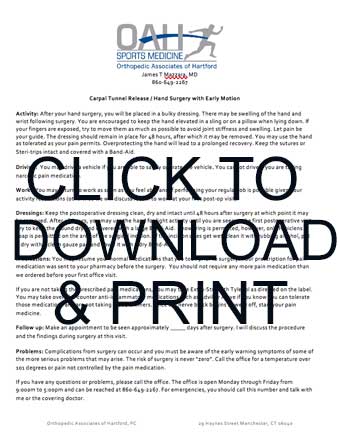Activity: After your acromioclavicular joint reconstruction, you will be placed in an arm immobilizer. This should be kept in place until you are seen in the office for your first post op visit on the first office day after the surgery. You should not move the arm at all. The shoulder immobilizer should be comfortable and hold your arm securely. The shoulder immobilizer will be fitted to you in the operating room but may seem loose when you get home. Adjust the Velcro on the straps to make it more secure and we will adjust it in the office again. Whatever you do, do not remove the immobilizer and do not move the arm. This could disrupt the repair leading to a failure of the surgery. When you are seen in the office, we will explain what you can and cannot do with the arm and when you may begin therapy.
You may use your hand and bend your fingers as much as you can tolerate right after surgery. Just do not move the shoulder.
If you had surgery at the surgery center, you will likely have a cooling cuff. Use it as directed as often as possible. It helps control swelling and pain. If you do not have a cooling cuff, apply ice packs to the shoulder for 20-30 minutes at a time as often as you need to control pain. Do not apply ice directly to the shoulder. Cover the shoulder with a towel then apply the ice packs.
Dressings: The post op dressing should remain in place until you are seen in the office where we will remove the dressing. It is normal to have drainage on the dressing after surgery. If the drainage soaks through the dressing, leave it in place and tape new gauze pads on top of the dressing. If this lasts more than 24 hours, call the office or go to one of our Orthopedic Associates of Hartford Urgent Care Centers to have it checked.
At the first office visit, the operative dressing will be removed, and the immobilizer will be checked and adjusted. It is OK to get the incisions wet in a shower after the first office visit but do not soak them in bath water for one week. Only Hibiclens soap may be used on the surgical site. After a shower, clean the incisions with alcohol and cover with a Band-Aid. Someone in the office or the therapist will show you how to remove and reapply the arm immobilizer and explain what types of motion are permitted. Once you learn this, you may shower and apply a shirt to wear under the immobilizer.
You must wear the shoulder immobilizer continuously, except when dressing, showering or doing therapy. You must even wear it while sleeping.
If you do not comply with the post-operative restrictions regarding shoulder motion, you will increase the chances of having the surgery fail and needing additional surgery.
Driving: You may not drive while wearing a shoulder immobilizer.
Work: You may return to work as soon as you feel able and performing your regular job is possible given your activity restrictions.
Medications: You may resume your normal medications that you took prior to surgery. Your prescription for pain medication was sent to your pharmacy before the surgery. You should not require any more pain medication than we ordered before your first office visit.
If you are not taking the prescribed pain medications, you may take Extra-Strength Tylenol as directed on the label (up to 1000mg every 6 hours). You are not allowed to take anti-inflammatory medications since they may interfere with the healing of your graft. Once the nerve block begins to wear off, start your pain medicine.
Unless you are allergic, take one aspirin 81mg twice per day to reduce the chances of blood clots. Blood clots may occur after any surgery or injury to the leg and may be associated with complaints of calf pain, calf cramping, pain in back of the knee, chest pain or shortness of breath.
Follow up: Make an appointment to be seen on the first office day after surgery. I will discuss the procedure and the findings during surgery at this visit.
Problems: Complications from surgery can occur and you must be aware of the early warning symptoms of some of the more serious problems that may arise. The risk of surgery is never “zero”.
Call the office for a temperature over 101 degrees, pain not controlled by the pain medication, or drainage from the incision that lasts more than 24 hours or calf pain, chest pain, or shortness of breath.
